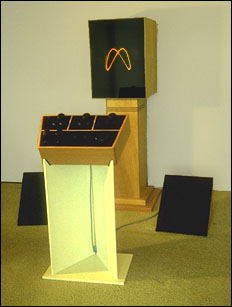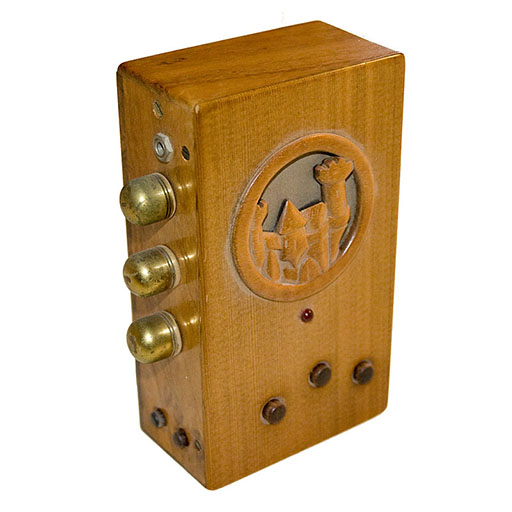
The Harmonic Visualizer is a device that allows you to see as well as hear musical harmonies. It is composed of three basic elements:
-
- A video screen
- Stereo speakers
- A control panel
The control panel determines what will appear on the screen and what will be heard from the speakers. The circuitry contains two musical oscillators, one of which is fixed in pitch and one of which can be varied with a large knob. The video screen plots the two sound waves against one another while the speakers play them both. Experienced technicians will know that this produces visual patterns known as lissajous figures. The Harmonic Visualizer allows you to manipulate these figures in multiple colors with considerable complexity and to hear them while you do so. Click here to see a diagram of the control panel.
When you have the two oscillators tuned in unison, you see a circle on the screen (a ratio of 1 to 1). When one is an octave above the other, you see a figure “8” (a ratio of 1 to 2, as seen in the photograph). The musical ratio of a fifth produces a more complex pattern (a ratio of 3 to 2). All musical harmonies represent integer ratios, so all musical harmonies produce stable, interesting patterns on the screen. When the two notes are NOT tuned to a musical harmony, you hear dissonance from the speakers and you see dissonance on the screen.
It’s interesting for the musician to compare visual harmonies on the screen with the musical harmonies coming from the speakers. You find that it may be difficult to “tune in” a perfect musical harmony by listening to the tones because the visual representation reveals with great accuracy when the audio harmony you thought was correct is, in fact, sharp or flat. You also find it is possible to create a complex visual harmony that represents an unusual musical harmony. What first sounded like noise can be heard to contain a complex harmony that is revealed on the screen.
In addition to this primary function, many controls are provided that affect the visible image. Wave shapes may be selected as sine waves or triangle waves. Each color may be set to an arbitrary level of brightness, and the duty cycle of the individual color guns may be modulated with a separate triangle or square wave of variable frequency to produce a very large variety of visual patterns composed of lines, bars, and dots in a multitude of colors.
No computer is used in the device. All patterns are produced by audio oscillators interacting with one another. The video screen is a 3 color vector device, as opposed to a raster scan screen like a television or computer uses. This means it works like an oscilloscope to draw continuous colored lines on its face rather than scanning back and forth to simulate continuous lines with many little segments of horizontal lines. This produces a much sharper image. The screen is a surplus monitor from an early type of arcade video game.
